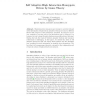WWW
2011
ACM
13 years 7 months ago
2011
ACM
Many malicious activities on the Web today make use of compromised Web servers, because these servers often have high pageranks and provide free resources. Attackers are therefore...
INFORMATICASI
2010
13 years 10 months ago
2010
Research in privacy-preserving data publishing has revealed the necessity of accounting for an adversary's background knowledge when reasoning about the protection afforded b...
GLOBECOM
2010
IEEE
13 years 10 months ago
2010
IEEE
The existing research on security issues in cognitive radio networks mainly focuses on attack and defense in individual network layers. However, the attackers do not necessarily re...
JCP
2007
14 years 22 days ago
2007
—Honeypots are computer systems designed for no purpose other than recording attacks on them. Cyberattackers should avoid them since honeypots jeopardize the secrecy of attack me...
SDM
2008
SIAM
14 years 2 months ago
2008
SIAM
Network security has been a serious concern for many years. For example, firewalls often record thousands of exploit attempts on a daily basis. Network administrators could benefi...
SIGMETRICS
2005
ACM
14 years 6 months ago
2005
ACM
Peer-to-peer (p2p) file sharing systems are characterized by highly replicated content distributed among nodes with enormous aggregate resources for storage and communication. Th...
SSS
2009
Springer
14 years 7 months ago
2009
Springer
High-interaction honeypots are relevant to provide rich and useful information obtained from attackers. Honeypots come in different flavors with respect to their interaction pote...
FC
2009
Springer
14 years 7 months ago
2009
Springer
Abstract. This paper analyzes the threat of distributed attacks by developing a two-sided multiplayer model of security in which attackers aim to deny service and defenders strateg...
HICSS
2009
IEEE
14 years 7 months ago
2009
IEEE
We analyze the strategic interactions among endusers and between end-users and attackers in mass and targeted attacks. In mass attacks, precautions by endusers are strategic subst...



